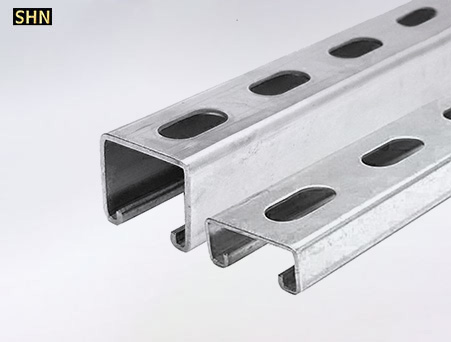+86 10 5248 4022
+86 18518927929

Jul. 26, 2023
Certainly, here are more frequently asked questions about strut channels:
Can unistrut be used for electrical applications?
Yes, slotted channels are commonly used in electrical applications to support conduit, cable trays, and other electrical components. They provide a sturdy framework for organizing and routing electrical wiring and equipment.
How do I determine the appropriate size of strut channel for my project?
The size of the strut channel is determined by factors such as the expected load, the type of accessories and equipment it will support, and the installation environment. Manufacturers provide load charts and engineering data to help you select the right size based on your specific requirements.
Can Half slot channel be used for suspending or hanging equipment from the ceiling?
Yes, strut channels are often used for hanging or suspending equipment and fixtures from the ceiling. Various fittings and accessories, such as hanging brackets and threaded rods, facilitate such installations.
Are there strut channels with corrosion-resistant coatings available?
Yes, some strut channels come with additional corrosion-resistant coatings, such as hot-dip galvanizing or powder coating, to enhance their durability in corrosive environments.
Can strut channels be used for non-metallic applications?
While metal channel strut are most common, there are also non-metallic options available, typically made from materials like fiberglass or PVC. These non-metallic strut channels are used in applications where electrical insulation or resistance to chemical corrosion is required.
Are there eco-friendly or sustainable strut channel options?
Some manufacturers offer eco-friendly strut channels made from recycled materials or materials with low environmental impact. These options cater to environmentally conscious projects and sustainable construction practices.
Can I easily modify or extend a strut channel system after installation?
Yes, one of the advantages of channel slotted is their ease of modification and extension. Accessories and fittings can be added or adjusted as needed, even after the initial installation, making them highly versatile and adaptable.
Are there industry standards that govern mounting strut channel specifications?
Yes, there are industry standards and codes that govern the design, manufacturing, and installation of strut channels. These standards ensure consistency, safety, and compatibility across different manufacturers and projects.
What is the difference between "back-to-back" and "side-to-side" strut channel configurations?
"Back-to-back" refers to two strut channels attached parallel to each other, providing increased load capacity and stability. "Side-to-side" refers to two strut channels connected side-by-side, offering increased width for mounting wider equipment or creating larger support structures.
Can I use strut channels in corrosive or hazardous environments?
Yes, certain materials, such as stainless steel or fiberglass strut channels, are suitable for use in corrosive or hazardous environments like chemical plants or marine installations.
Can I get custom-designed channel strut for my unique project needs?
Many manufacturers offer custom-designed strut channels, allowing you to tailor the dimensions, hole patterns, and other specifications to meet your specific project requirements.
Always consult with manufacturers, suppliers, or engineering professionals to ensure that you are using the appropriate strut channel and accessories for your particular application. Additionally, local building codes and regulations should be adhered to when incorporating strut channels into construction projects.

Previous mounting channel strut
Slotted Channel - for light structural support
Dec. 11, 2023How to Attach slotted channel to a Beam?
Dec. 11, 2023Leave Message
Write down your urgent needs to get free samples, and to check our stocks

Copyright © SS&HN INDUSTRY GROUP Ltd. All Rights Reserved | Sitemap | Powered by 